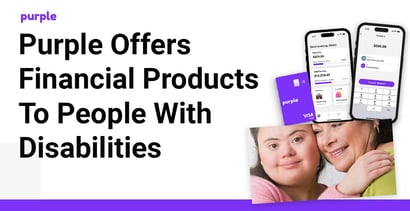
In a Nutshell: Purple provides financial products and services uniquely designed to meet the needs of people with disabilities. The Achieving a Better Life Experience (ABLE) Act has paved the way for tax-advantaged savings programs for people with disabilities. Purple is working to build awareness of the ABLE Act. Its ABLE account allows people to save for qualified disability expenses. Purple’s future goals include building a full suite of financial products for people with disabilities.
Purple is a regal color. Its majestic appearance has long been associated with royalty and wealth. The price of purple dyes was once exorbitant in comparison to the price of other colored dyes. The cost of purple dye served to restrict ownership of purple garments to only the upper echelon of society.
Purple is also Christian Ciocca’s favorite color. Christian, who has Down syndrome, is the inspiration behind the company Purple, which provides financial products and services for people with disabilities. John Ciocca is Christian’s brother and the Founder of Purple.

“In addition to the historical significance of the color purple, and its associations with wealth and royalty, purple has always been a popular color in the disabled community,” John Ciocca said. “It’s an inclusive color, and it’s also Christian’s favorite. It’s really the perfect name for my company, which is dedicated to building inclusive financial products for people with disabilities.”
Prior to launching Purple, John Ciocca built a social network for people with disabilities called youBelong. It brought together a large community of people with disabilities and their families and friends. John Ciocca’s interactions with the community exposed him to the financial challenges that many people with disabilities face.
Supplemental Security Income (SSI) is a Social Security program that provides financial support to people with disabilities. The requirements for receiving the benefit can discourage SSI recipients from building savings.
“SSI is a means-tested benefit,” Ciocca explained. “If you receive disability benefits, you can’t have more than $2,000 in assets, including checking, savings, and investment accounts. If you do have more than $2,000 in assets, then the government thinks you don’t need disability benefits anymore and will stop them. This penalty can stop people with disabilities from saving, investing, and even seeking employment.”
ABLE Eligibility Expanding to Help Others
The ABLE Act was passed in 2014 and addresses some of the concerns people with disabilities and their families had with the parameters of SSI.
The ABLE Act enables states to create tax-advantaged savings programs for people with disabilities. Funds in an ABLE account don’t count toward the $2,000 SSI asset limit.
ABLE accounts function similarly to 529 college savings plans, but ABLE accounts don’t enjoy nearly the same level of name recognition that 529 plans do.
“A lot of the people who worked so tirelessly on Capitol Hill to get the ABLE Act passed are a little disappointed in its adoption and progress,” Ciocca said. “ABLE hasn’t been a huge success so far because states haven’t really taken it anywhere. Many eligible individuals and their families aren’t familiar with ABLE accounts and the benefits it can provide.”

People with disabilities who were disabled prior to age 26 are eligible to open ABLE accounts. Ciocca said approximately 8 million people in the U.S. are eligible to open these accounts.
Beginning in 2026, ABLE eligibility will include individuals who are disabled prior to reaching the age of 46. Ciocca said this expansion is estimated to increase the number of people eligible to participate in an ABLE program by 6 million, including 1 million veterans.
ABLE account funds can only be withdrawn to pay for qualified disability expenses (QDEs). Ciocca said qualified disability expenses are essentially anything that benefits the individual with a disability, including expenses for food, housing, transportation, and medical benefits.
“Generally, as long as funds are being used for the benefit of the person with a disability, it’s an eligible expense,” Ciocca said. “ABLE accounts are actually opened in the name of the individual with the disability. So that can be very empowering — it’s their account, and it’s their money.”
People With Disabilities Have a Partner in Purple
Purple is focused on building financial products and services for people with intellectual disabilities, including Down syndrome and autism. Purple’s products can be used either directly by people with disabilities or by their parents or caregivers who help manage their finances.
Ciocca said Purple’s ABLE account may be a customer’s first ABLE account they have opened.
“ABLE accounts are investment accounts,” he said. “Another reason ABLE adoption is low is because, for many families, this is the first time they are investing. They’ve set aside funds to open their account, and when they do, they’re encountering questions asking whether they want a conservative, moderate, or aggressive portfolio. That language can be intimidating to first-time investors who just want their money to be safe.”

Purple’s checking account was designed to assuage people’s fears concerning placing their money in an investment vehicle that might lose value. Ciocca said the account, which qualifies as an ABLE account, functions in the same manner as a standard bank checking account.
Another account component is a qualified disability expense routing feature that automatically chooses between ABLE funds or checking account funds to pay for a purchase depending on which funds are the most tax-advantaged. Purple offers a waiting list for customers interested in this product.
“Our plan is to start simple,” Ciocca said. “Not everyone wants their account to go up and down with the market, so this account is designed to help people save while providing instant access to funds. And more sophisticated features for those seeking additional account benefits.”
Tax-Advantaged Accounts Help Savings Grow
ABLE accounts have tax benefits that can help balances grow more quickly over time. Ciocca said in-state, gifted contributions to ABLE accounts are tax deductible.
Another powerful advantage Ciocca discussed is that employers of people with disabilities can contribute to employees’ ABLE accounts. Those contributions are not counted toward the account holder’s annual contribution limit.
Ciocca said he is excited to help people “connect the dots” of all the different benefits ABLE accounts offer. He is working with organizations that focus on helping people with disabilities, including Special Olympics, the National Disability Institute, and the Financial Health Network, to help spread the word about Purple and ABLE accounts. Ciocca said he also relies on word-of-mouth marketing.

“Parents of children with disabilities are a very tight-knit community,” Ciocca said. “Trust is very important to the community.”
In addition to continuing to build awareness, Ciocca said his future goals include offering a full suite of credit-building, financial planning, and investing products. His long-term goals are to build products for anyone from new parents to people who are injured on the job later in life.
“Building awareness and growing our product offering is really just part one,” Ciocca said. “But there’s a lot more to come. There are people pushing for policy change that will positively impact how people with disabilities are able to manage their finances. There’s a lot of great things happening in this space, and we’re happy to help drive this mission forward by providing robust financial products and services for people with disabilities.”






